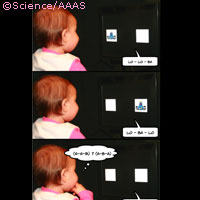Bilingual infants more flexible in language learning
Do children benefit from learning two languages instead of just one? A team of EU-funded researchers say they do. Published in the journal Science, the EU-funded study's findings demonstrate that infants exposed to two languages develop more flexible learning strategies when dealing with linguistic stimuli. The study is an outcome of the CALACEI ('Universal and specific properties of a uniquely human competence: tools to study language acquisition in early infancy: brain and behavioural studies') project, funded with EUR 1.5 million through the 'New and emerging science and technologies (NEST)' Thematic area of the Sixth Framework Programme (FP6), and was also part of the FP6 DISCOS ('Disorders and coherence of the embodied self') project, funded with EUR 3 million under the 'Human resources and mobility' Thematic area. One of the researchers was also supported by an FP6 Marie Curie grant. A well-defined timeframe is instrumental in helping children acquire their native language, according to researchers. Despite the fact that children raised in bilingual homes learn roughly twice as much about language as their monolingual peers, there is no major difference in the speed at which bilingual and monolingual children acquire language. The study shows that bilingual and monolingual infants who produce their first words when they turn 1 can produce 50 words by the time they are 18 months old. The researchers from the International School for Advanced Studies (SISSA) in Italy assessed pre-verbal 12-month-old bilingual infants. They found that these children are more adaptable at learning speech structures versus their monolingual peers. 'When given the opportunity to simultaneously learn two different regularities, bilingual infants learned both, while monolinguals learned only one of them,' the authors write. 'Hence, bilinguals may acquire two languages in the time in which monolinguals acquire one because they quickly become more flexible learners.' The researchers suggest that bilingual infants are able to acquire two languages just as fast as monolinguals learn one because they have more experience in learning in a 'mixed input' environment. 'Bilinguals have to learn a distinct set of properties for each of the languages from a multi-language input, while avoiding interference between the two languages,' the study says. 'Thus, they might recruit specific mechanisms that help them to simultaneously extract patterns from two languages even before they start speaking.' The researchers, Dr Ágnes Melinda Kovács (currently at the Hungarian Academy of Sciences) and Professor Jacques Mehler, presented the infants with three-syllabic words: lo-ba-lo (ABA) or lo-lo-ba (AAB) in structure, followed by toys depicted either on the left or right side of the screen. 'The speech item's structure predicted the location of the toy,' the authors write. 'For example, if the speech item conformed to an ABA structure, the toy appeared on the right side of the screen, while it appeared on the left side if the structure was AAB.' The infants were then presented with words they had never heard but that corresponded to one of the two structures; no toy was presented. The researchers recorded where the infants looked after hearing each new word to determine whether they had learned the structures. 'If they learned the structures, they should first search for the toy where it used to appear for that specific structure,' the researchers explained. At the end of the day, young children will benefit from being exposed to multiple languages early in their lives. Not only are they more flexible at learning speech structures, but they are also able to monitor different languages structures simultaneously in comparison with their monolingual peers.
Countries
Italy



